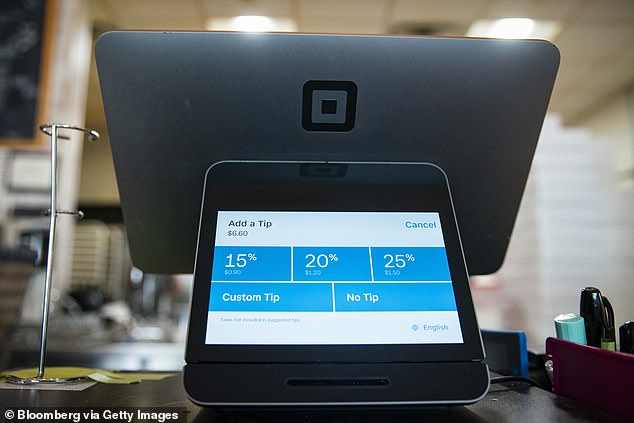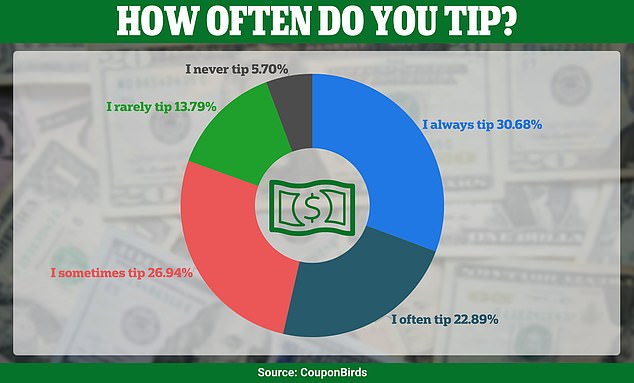- During the pandemic, Americans began tipping larger sums, more frequently.
- But now they’re fed up with machines putting more and more pressure on them to tip more.
- Payment Data Indicates Average Restaurant Tip Is Declining
<!–
<!–
<!–
<!–
<!–
<!–
Electronic payment machines – in which customers must choose an amount to tip using a large screen in front of a server – forced Americans to pay increasingly larger tips.
But now they are fighting back after use of the screens – with options often starting at 18 percent and rising as high as 35 percent – caused average tips to become inflated.
Average tips at local restaurants rose above 20 percent for the first time in 2020 and remained above that level throughout the pandemic, peaking at nearly 20.5 percent as “tip inflation” persisted. “.
But Americans are now tipping less, according to data from payment processing company Toast. In the final three months of last year, the average tip dropped to 19.4 percent.

Payment systems with digital screens allow restaurants to offer consumers suggestions on how much to tip


Three-quarters of Americans believe tipping culture has gone too far
The latest tipping figures come after a survey showed Americans are growing tired of digital payment machines urging them to tip more and in a wider range of transactions.
Nearly 3 in 4 Americans think tipping has gotten out of control, according to a WalletHub survey.
When adding a tip via credit card or digital payment, ‘full-service’ restaurant guests tipped 19.4 percent on average in the fourth quarter of 2023, according to a separate study. Recent restaurant trends report. per toast.
That’s down from a high of nearly 20.5 percent during the height of the pandemic and down from pre-pandemic levels of 19.5 percent in 2018.
With the emergence of new payment systems, the frequency with which people tip at “quick service establishments” such as coffee shops and fast food restaurants has also increased.
Between the beginning of 2020 and the end of 2022, the number of people tipping at quick-service restaurants increased between 11 percent and 48 percent.
Professor Michael Lynn, professor of consumer behavior at Cornell University, told DailyMail.com: ‘iPad screens make it harder for customers to say no.
‘Before, customers simply saw a tip jar and could ignore it if they wanted. But now they have to actively say “no.” Many people queue in a cafe and worry about what the man behind them thinks.’
Tim Self, assistant professor of hospitality at Austin Peay State University in Clarksville, Tennessee, he told CNBC customers feel like they are tipping in more places.
‘Customers are asked to tip in more traditional service encounters. [and] also app-based services, ride-sharing apps and home delivery,” he said. “This gives the impression that tipping is everywhere, which seems to be the case.”


Many Americans say they felt guilty about the deployment of large payment machines with screens offering suggested tipping amounts.
Not only did this initially increase tips, but those referrals also began to increase. One in three consumers has noticed that tip tips are higher than before, according to PYMNTS research.
While a 20 percent tip at a full-service restaurant is a fairly well-established standard, how much and when to tip at a quick-service establishment is less uncertain.
Payment data in the report also indicated that tips vary significantly depending on the day of the week.
Customers will be stingier when tipping on Sundays and will gradually increase amounts through Thursday. On Fridays and Saturdays tips went down again.
Last year, DailyMail.com revealed that Square, which sells the software and hardware that powers many of these next-generation electronic payment systems, made a staggering $3 billion in profit in 2022 alone.
said nbc news that the frequency of tipping at quick-service restaurants, including cafeterias and fast-food chains, increased 16 percent in the final quarter of 2022 compared to the same period a year earlier.
